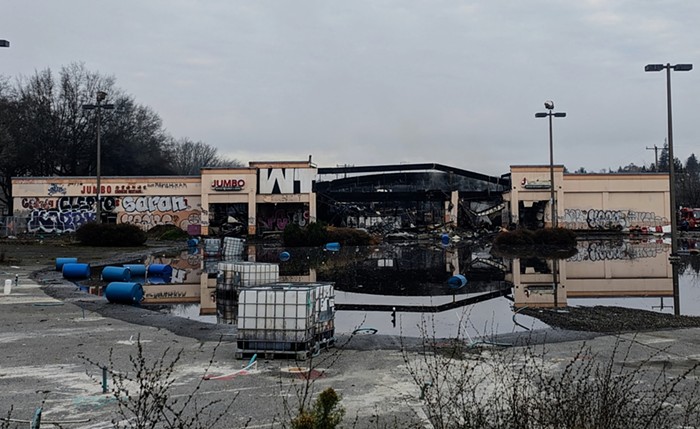It is very well known that Mayor Bruce Harrell "campaigned against broad upzones of single-family neighborhoods..." So it is no surprise that his office is presently attempting to soften the blow of the new rule that requires cities with 75,000 residents to permit what legislators in Olympia described as "middle housing in areas traditionally dedicated to single-family detached housing." Governor Inslee's signature made the requirement, HB 1110, a law of the state on May 8. But despite HB 1110 being at best mediocre and generally popular, our sweep-happy mayor is now all of a sudden concerned that it will displace "longtime residents... by redevelopment or gentrification."
Though there is something to this concern—the changes in zoning rules might modestly increase density but, because housing remains in the market, it might have little to no impact on the kind of affordability market urbanists dream of—Bruce Harrell is in no way proposing the path to real affordability, social housing. He is instead clinging to an old market regime (single-family zoning) that is even worse than market density and has yet to offer anything like resistance to gentrification. But Harrell does represent a form of resistance that is as old as market-rate urbanism. This is the resistance to density.
The @MayorofSeattle is looking into ways to keep housing banned in Seattle under the new statewide middle housing bill. https://t.co/biWtvb6039
— The Urbanist (@UrbanistOrg) May 22, 2023
The thing that must be understood, and is consistently missed by market urbanists who see HB 1110 as a morgenröte of the density that characterizes the world's urban superstars (Tokyo, Paris, Barcelona, and the like), is that the capitalist conditions for housing affordability have tended to require an economic catastrophe. This is a story Detroit can tell you all about. The same goes for almost all post-war urban cores. Massive capital devaluation is not something you want to see or experience. Furthermore, there has yet to be a market-dominated city that has built its way to affordability. That is not the logic of capital, which is not about people, but things. And that is why HB 1110 will certainly not present a downward curve to the cost of living in Seattle and elsewhere. History has shown that cheap housing comes two ways in an economy dominated by the seemingly eternal rules of exchange value: capital devaluation and de-commodification. The second requires that housing is supplied like a public utility: water, electricity, waste removal, and so on.
The mid-century scholar who brought the most light to this fact is Ruth Glass. Read her magisterial essay "London: Aspects of Change" (1964), and also a section of an earlier (1955) essay "Urban Sociology in Great Britain: A Trend Report." The market has never solved, in a humane way, a housing crisis in its entire history of existence. Not once. I kid you not. What it has done instead (and this points to the true status of the moderate left in our day) is generate many urban planning and architecture schools that have only addressed the catastrophe of unchecked capital deflation—slums, townships, favelas, and so on—entirely within the context of what caused the deflation, the market itself.
In the 1960s, sociologist Ruth Glass was the first to recognize and use the term “gentrification.” This is how she explained it. What do you mean when you use the term? (And read more about #gentrification here: https://t.co/eqYgtjiiRi)
— Shelterforce (@Shelterforce) July 1, 2022
📷 Headshot from @LondonU and @odnb pic.twitter.com/lr6esgouZT
And it is in this fact that we find in the old and still strong resistance to what the world really needs now: density. Density is entirely associated with the consequences (also known as social ills) of capital devaluation.
Ruth Glass in Cliches of Urban Doom:
The Victorians expressed their anxiety in unmistakable terms. Cooke Taylor in his Notes of a Tour in the Manufacturing Districts of Lancashire in 1842 had this to say of Manchester:
"As a stranger passes through the masses of human beings which have been accumulated round the mills and print-works in this and the neighbouring towns, he cannot contemplate those 'crowded hives' without feelings of anxiety and apprehension almost amounting to dismay. The population... is hourly increasing in breadth and strength. It is an aggregate of masses, our conceptions of which clothe themselves in terms that express something portentous and fearful. We speak of them... as of the slow rising and gradual swelling of an ocean which must, at some future and no distant time, bear all the elements of society aloft upon its bosom, and float them - Heaven knows whither. There are mighty energies slumbering in those masses."
Glass found the same feeling expressed "over 60 years later" in C.F.G. Masterman's The English City. After World War II, the negative feeling resulted in the massive move to the suburbs in American cities. Today, it is the true source of resistance to density, even in Seattle. But density without the de-commodification of a massive section of housing will only continue an urban catastrophe that has been with us since the birth of a social form with the market as its motive force.



















